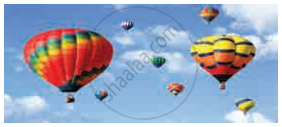Advertisements
Advertisements
प्रश्न
A small bubble rises from the bottom of a lake where the temperature and pressure are 6°C and 4 atm. to the water surface, where the temperature is 25°C and pressure is 1 atm. Calculate the final volume in (mL) of the bubble, if its initial volume is 1.5 mL.
उत्तर
T1 = 6°C + 273 = 279 K
P1 = 4 atm
V1 = 1.5 ml
T2 = 25°C + 273 = 298 K
P2 = 1 atm
V2 = ?
`("P"_1"V"_1)/("T"_1) = ("P"_2"V"_2)/("T"_2)`
V2 = `("P"_1"V"_1)/("T"_1) xx "T"_2/"P"_2`
= `(4 "atm" xx 1.5 "ml" xx 298 "K")/(279 "K" xx 1 "atm")`
V2 = 6.41 ml
APPEARS IN
संबंधित प्रश्न
Give reason for the following:
Gases exert pressure in all directions.
Convert the following pressure value into Pascals.
10 atmosphere
Convert the following pressure value into Pascals.
1 atmosphere
Hot air balloons float in the air because of the low density of the air inside the balloon. Explain this with the help of an appropriate gas law.

Use of hot air balloon in sports and meteorological observation is an application of
For a given mass of an ideal gas, which of the following statements is CORRECT?
Isochor is the graph plotted between ______.
A gas occupies a volume of 4.2 dm3 at 101 kPa pressure. What volume will gas occupy if the pressure is increased to 235 kPa keeping the temperature constant?
If 300 mL of a gas at 26.85°C is cooled to 6.85°C at constant pressure. What will be the final volume of gas?
At what temperature, the volume of gas would become zero?
